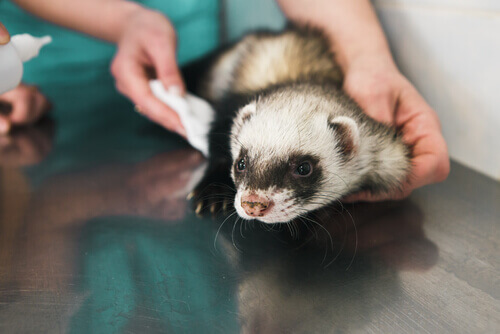Canine Distemper Virus in Ferrets: Causes, Symptoms, and Treatment

Ferrets have become fashionable pets in recent years. However, many people don’t know how to care for them, which is why you’ll need some tips if you’ve decided to have this animal as a pet. In this article, we talk about canine distemper virus in ferrets. Did you know that this virus could affect them? Well it can! Below, we’ll tell you all about it.
What’s canine distemper virus in ferrets?
Distemper is a disease that’s always affected dogs. However, it can also affect ferrets. It’s an abnormality caused by a virus that can be spread through the air or through contact with sick animals.
Unfortunately, many ferrets die due to this condition. Thus, you play a fundamental role in making sure it doesn’t happen to yours! The main thing is to be well informed.
The causes of canine distemper virus (CDV) in ferrets
This virus belongs to the Paramyxoviridae family. The main way it spreads is through contact with an infected animal. This could be another ferret, a dog, or any other wild animal that’s infected with the disease.

Contact with feces or secretions of a sick animal could be another cause of canine distemper virus (CDV) in ferrets. In fact, even an object that an infected dog used and that your ferret later finds would make it sick if not enough hours have passed between contact and contact. This is because distemper viruses can survive hours outdoors attached to something; in this case, an object that could very well be a toy.
In fact, you could accidentally infect your ferret with distemper. If you visit a sick animal and you don’t disinfect yourself well before entering your house, you could carry this organism in your clothes, your hands, or your shoes.
The symptoms of canine distemper virus (CDV) in ferrets
How can you know if your ferret has this disease? There are some easily recognizable symptoms that you should be able to detect to be able to act as soon as possible. This is essential, since 99% of ferrets who catch it die, and many of these deaths are due to not acting in time.
The first thing to know is that distemper in ferrets has an incubation period of ten days. Thus, when you start taking measures, your animal will have already been sick for several days. Urgency is vital if you want to save your pet’s life.
In this regard, you should watch your ferret carefully and act quickly by going to the vet if you see any of the following signs:
- Firstly, ocular and/or nasal discharge
- Eye infection
- Apathy
- Lethargy
- Loss of appetite
- Depression
- Diarrhea
- Dehydration
- Sensitivity to light
- Fever
- And, finally, peeling skin
These are the most common symptoms. However, if you notice other changes that aren’t on this list, you should take your ferret to the vet, just in case. Since ferrets are very sensitive to disease, acting quickly is vital and can save their lives.

Treatment for distemper in ferrets
Although there’s no explicit treatment for this condition, there is a treatment for each of its symptoms. That’s why, as we mentioned above, you should take your ferret to the vet if you notice any of them.
The treatment consists of hydrating the animal and applying intravenous drugs and other fluids that boost its immune system.
Remember that prevention is key, meaning you need to be careful about the contact your ferret has with other animals. Also, you need to keep their vaccinations up to date, especially the distemper one.
In short, we hope we gave you all the information you need to keep your ferret from contracting this near-fatal disease. If you act on time, your pet could be one of the 1% who survive.
https://misanimales.com/moquillo-hurones-causas-sintomas-tratamiento/
Ferrets have become fashionable pets in recent years. However, many people don’t know how to care for them, which is why you’ll need some tips if you’ve decided to have this animal as a pet. In this article, we talk about canine distemper virus in ferrets. Did you know that this virus could affect them? Well it can! Below, we’ll tell you all about it.
What’s canine distemper virus in ferrets?
Distemper is a disease that’s always affected dogs. However, it can also affect ferrets. It’s an abnormality caused by a virus that can be spread through the air or through contact with sick animals.
Unfortunately, many ferrets die due to this condition. Thus, you play a fundamental role in making sure it doesn’t happen to yours! The main thing is to be well informed.
The causes of canine distemper virus (CDV) in ferrets
This virus belongs to the Paramyxoviridae family. The main way it spreads is through contact with an infected animal. This could be another ferret, a dog, or any other wild animal that’s infected with the disease.

Contact with feces or secretions of a sick animal could be another cause of canine distemper virus (CDV) in ferrets. In fact, even an object that an infected dog used and that your ferret later finds would make it sick if not enough hours have passed between contact and contact. This is because distemper viruses can survive hours outdoors attached to something; in this case, an object that could very well be a toy.
In fact, you could accidentally infect your ferret with distemper. If you visit a sick animal and you don’t disinfect yourself well before entering your house, you could carry this organism in your clothes, your hands, or your shoes.
The symptoms of canine distemper virus (CDV) in ferrets
How can you know if your ferret has this disease? There are some easily recognizable symptoms that you should be able to detect to be able to act as soon as possible. This is essential, since 99% of ferrets who catch it die, and many of these deaths are due to not acting in time.
The first thing to know is that distemper in ferrets has an incubation period of ten days. Thus, when you start taking measures, your animal will have already been sick for several days. Urgency is vital if you want to save your pet’s life.
In this regard, you should watch your ferret carefully and act quickly by going to the vet if you see any of the following signs:
- Firstly, ocular and/or nasal discharge
- Eye infection
- Apathy
- Lethargy
- Loss of appetite
- Depression
- Diarrhea
- Dehydration
- Sensitivity to light
- Fever
- And, finally, peeling skin
These are the most common symptoms. However, if you notice other changes that aren’t on this list, you should take your ferret to the vet, just in case. Since ferrets are very sensitive to disease, acting quickly is vital and can save their lives.

Treatment for distemper in ferrets
Although there’s no explicit treatment for this condition, there is a treatment for each of its symptoms. That’s why, as we mentioned above, you should take your ferret to the vet if you notice any of them.
The treatment consists of hydrating the animal and applying intravenous drugs and other fluids that boost its immune system.
Remember that prevention is key, meaning you need to be careful about the contact your ferret has with other animals. Also, you need to keep their vaccinations up to date, especially the distemper one.
In short, we hope we gave you all the information you need to keep your ferret from contracting this near-fatal disease. If you act on time, your pet could be one of the 1% who survive.
https://misanimales.com/moquillo-hurones-causas-sintomas-tratamiento/
This text is provided for informational purposes only and does not replace consultation with a professional. If in doubt, consult your specialist.








